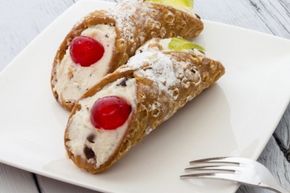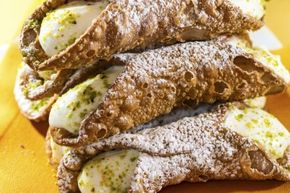By: Maria Trimarchi

"Leave the gun; take the cannoli," said Clemenza, a man who clearly had his food priorities straight, in "The Godfather." But what were those cannoli filled with, ricotta or mascarpone?
Cannoli is a sweet Italian pastry, a tube-shaped, crumbly shell made from fried dough with a sweet, creamy filling. Some preparations include the addition of candied fruit (commonly cherries or orange peel), pistachio nuts or sometimes cocoa or cinnamon.
Advertisem*nt
The dessert is considered an Italian specialty, but it's actually considered to be of Sicilian descent. People have been eating the sweet treat since ancient times. Roman philosopher and orator Marcus Tullius Cicero mentioned cannoli-like pastry as long ago as 70 BCE, and some historians consider it likely became popular as a special indulgence during Carnivale, a Christian celebration occurring between Epiphany in early January and the beginning of Lent -- like Mardi Gras, but with cannoli. Some trace the dessert's history to the harem of Caltanissetta, and that "cannoli" actually comes from the Arab, "Kalt el Nissa" (which means city of women) [source: La Cucina Eoliana e Siciliana].
Regardless, though, whether it was a decadent Carnivale dessert or a symbol of fertility, the thing about classic cannoli that Italians do agree on is this: a cannolo (that's a single piece of the pastry) is filled with a ricotta cheese mixture sweetened with sugar (or honey) and a flavoring such as orange-flower water (or vanilla or rosewater). So, then, why have you likely eaten varieties filled with mixtures other than ricotta? We've heard of cannoli filled with mascarpone, cream cheese, even custard or ice cream. While they may all be sweet and creamy, they're not all true to the dessert.
Advertisem*nt
Cannoli Filling: Ricotta or mascarpone cheese?

Cannoli have a creamy filling, but that's not whipped cream, pastry cream or custard that you're enjoying; it's cheese. And, traditionally, it's fresh sheep's milk ricotta.
Ricotta is a soft, white cheese made from whey (which is a protein that's left over when you process dairy to make other types of cheeses, such as the hard cheese, pecorino). It's low fat and a little grainy -- kind of like a sweeter, smoother type of cottage cheese. However, fun fact: Because it's made from a cheese-making by-product, it's not technically itself a cheese (cheeses are made from milk), although we all refer to it that way. In the U.S., ricotta is most often made from the whey of cow's milk, but a traditional cannolo is filled with sweetened fresh sheep's milk ricotta that's been blended until smooth. The difference, aside from which animal the milk comes from, between ricotta from cow's milk versus that made from sheep's milk comes down to flavor -- cow's milk ricotta is considered to have a milder taste compared to other ricottas.
Advertisem*nt
Because of its soft, liquidy texture, ricotta is strained before it's used in pastry filling.
Ricotta is the filling of choice; but that's only according to tradition.
While it has a somewhat similar flavor profile to ricotta, mascarpone cheese is a thick, high-fat, triple cream cheese with a texture more like butter or custard than the slightly grainy texture of ricotta. It's a soft cheese, like cream cheese or Neufchatel, and made from cow's milk. This Italian cheese is at home in another Italian dessert favorite, tiramisu, but often it's used as a filling for cannoli made in the U.S. instead of whole-milk ricotta. Why? Mostly because of its moisture content, or lack thereof. Because mascarpone is thicker and denser than ricotta, you're less likely to have problems with it -- too much moisture can turn into runny filling and soggy pastry, which is why it's important to drain your ricotta before using it, but even drained your ricotta-based filling may still have too much moisture. Some recipes and bakers prefer to skip the ricotta altogether; or use a ricotta and mascarpone blend, which offers the best of both cheeses -- a flavor similar to that of traditional ricotta with the creaminess of mascarpone.
Advertisem*nt
Mascarpone or Ricotta for Cannoli FAQ
What is cannoli filling made of?
A cannoli is typically filled with a sweet filling that's made out of ricotta — according to tradition, at least. However, some people choose to use mascarpone instead because it's thicker, higher in fat and easier to control.
Why is my cannoli filling grainy?
Ricotta cheese, the traditional cannoli filling, can be grainy due to its mixture of curds and whey. The moisture content in ricotta can make the gritty, grainy feel stand out.
Which is healthier, ricotta or mascarpone?
Ricotta is lighter and less fat-filled, while mascarpone is similar to cream cheese. This makes ricotta a healthier choice.
Can you use mascarpone instead of ricotta in cannoli?
Yes, you can absolutely swap out ricotta for mascarpone when you're making cannoli.
Is cannoli made with ricotta or mascarpone?
Cannoli is traditionally made with ricotta, but some people prefer mascarpone. It simply depends on your personal preference.
Lots More Information
Author's Note: Should you use mascarpone or ricotta for cannoli?
I'm pretty sure I gained a few pounds just thinking about this article, not including any taste-testing research that, naturally, needed to happen. I've eaten cannoli with all types of fillings: classic ricotta, sweetened mascarpone, and the ricotta/mascarpone mixture. And my favorite? Ah, ricotta.
Related Articles
- 10 Most Decadent Pastries Ever Conceived
- Top 10 Most Extraordinary Baking Sensations
- Top 10 Most Popular Desserts in America
- Name That Pastry Quiz
More Great Links
Sources
- Cheese.com. "Fresh Ricotta." (April 25, 2014) http://www.cheese.com/fresh-ricotta/
- Cheese.com. "Mascarpone." (April 25, 2014) http://www.cheese.com/mascarpone/
- DeLallo Foods. "Ricotta: The Cheese that Isn't A Cheese." (April 25, 2014) http://www.delallo.com/articles/ricotta-cheese
- Gangi, Roberta. "Cannoli." Best of Sicily Magazine. 2006. (April 25, 2014) http://www.bestofsicily.com/mag/art208.htm
- Gruppo Virtuale Cuichi Italiani (GVCI). "'Leave the gun, take the cannoli'. 'There is no better morsel in the world'." 2014. (April 25, 2014) http://www.itchefs-gvci.com/index.php?option=com_content&view=article&id=333&Itemid=717
- Italia. "Italian Carnivals." (April 25, 2014) http://www.italia.it/en/travel-ideas/culture-and-entertainment/italian-carnivals.html
- La Cucina Eoliana E Siciliana. 2012. (April 25, 2014) http://www.lacucinaeoliana.com/index_2.html
- Roberts, Kathryn. "Why Does Cannoli Cream Come Out Watery?" GlobalPost. (April 25, 2014) http://everydaylife.globalpost.com/cannoli-cream-come-out-watery-40875.html
- WebFoodCulture.com. "Cannoli of Cicero." 2013. (April 25, 2014) http://webfoodculture.com/dessert/cannoli-of-cicero/
Cite This!
Please copy/paste the following text to properly cite this HowStuffWorks.com article:
Citation
Advertisem*nt
Advertisem*nt
Loading...
\n\n\t\t\t\t
`;t.byline_authors_html&&(e+=`By: ${t.byline_authors_html}`),t.byline_authors_html&&t.byline_date_html&&(e+="|"),t.byline_date_html&&(e+=t.byline_date_html);var i=t.body_html.replaceAll('"pt','"pt'+t.id+"_");return e+=`\n\t\t\t\t
\n\t\t\t\t
\n\n\t\t\t\t
${i=i.replaceAll("#pt","#pt"+t.id+"_")}
\n\n\t\t\t
`}(a);this.loadedDiv.innerHTML+=n,document.title=a.title+" | HowStuffWorks";let s="content-loaded-"+a.id,l=document.getElementById(s);l.dataset.contentId=a.id;let o=l.querySelectorAll(".lazyload");HSW.utilities.lazyLoadElements(o),HSW.ux.editorial.init({twitter:!0,facebook:!0,instagram:!0}),l.querySelectorAll(".toc a").forEach(t=>{t.addEventListener("click",t=>{t.preventDefault();let e=t.target.dataset.target,i=document.querySelector("a[name='"+e+"']");i?i.scrollIntoView({behavior:"auto"}):console.error("Unable to locate target with name "+e)})});try{if(userData.adsActive)if(HSW.utilities.isMobile()){l.querySelectorAll(".ad-mobinline").forEach(t=>{t.setAttribute("id","ad-wrap-mobinline"+r),t.childNodes[0].setAttribute("id","ad-div-mobinline"+r),void 0!==HSW.ads&&HSW.pq.add(()=>{HSW.ads.addNewUnits(["ad-div-mobinline"+r])},"ads"),r++})}else{let t=document.createElement("div");t.setAttribute("id","ad-after-"+e),t.classList.add("ad-inline","mb-8","bg-gray","w-max-full","h-min-90","text-center");let a=document.createElement("div");a.setAttribute("id","ad-div-inline"+i),t.appendChild(a),l.after(t),void 0!==HSW.ads&&HSW.pq.add(()=>{HSW.ads.addNewUnits(["ad-div-inline"+i])},"ads")}}catch(t){console.error(t)}if(window.setupSinglePageUX(l),history.pushState)try{history.pushState(null,a.title+" | HowStuffWorks",a.href)}catch(t){console.warn(t)}var c=[];a.taxonomy.forEach((t,e)=>{c[e]=t.title.toLowerCase()});var d=c.join("/"),h=[];a.authors.forEach((t,e)=>{h[e]=t.first_name.toLowerCase()+" "+t.last_name.toLowerCase()});var g=h.join(",");pageMetricsData.href=a.href,pageMetricsData.title=a.title,pageMetricsData.tax=d,pageMetricsData.aType=a.asset_type,pageMetricsData.cType=a.type+"-continuous",pageMetricsData.template=a.template,pageMetricsData.source=a.source,pageMetricsData.sponsor=a.sponsor,pageMetricsData.author=g,pageMetricsData.contentid=a.id,pageMetricsData.image=a.hero_image,pageMetricsData.page=0,pageMetricsData.pubDate=a.publish_date.slice(0,10),pageMetricsData.editDate=a.last_editorial_date.slice(0,10);const u=/[^\da-z_]/i;let p=HSW.utilities.isMobile()?"hsw_lite":"hsw";a.taxonomy.slice(1,3).forEach((t,e)=>{p+="|"+t.title.replace(u,"").toLowerCase()}),pageMetricsData.adUnit=p,Alpine.store("share",{title:pageMetricsData.title,url:pageMetricsData.href,image:pageMetricsData.image}),function(t,e){let i=t.href.split(".com/").pop();dataLayer.push({event:"virtual-page-view",virtualPageUrl:i,virtualPageTitle:document.title,pageNbr:0}),dataLayer.push({event:"raw-event-interactive",eventCategory:"page-interaction",eventAction:"continuous-load",eventLabel:"new-content",eventValue:e+1,virtualPageUrl:t.href})}(a,this.items.length);const m={...pageMetricsData};t.items.push(m);for(var f=document.getElementsByClassName("new-content-loaded"),v=0;v
